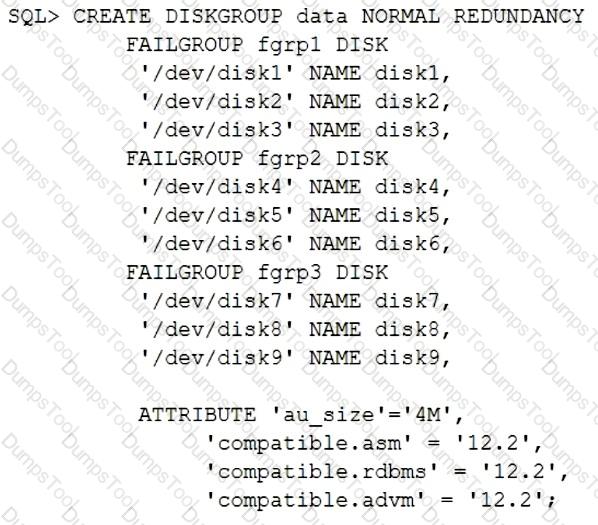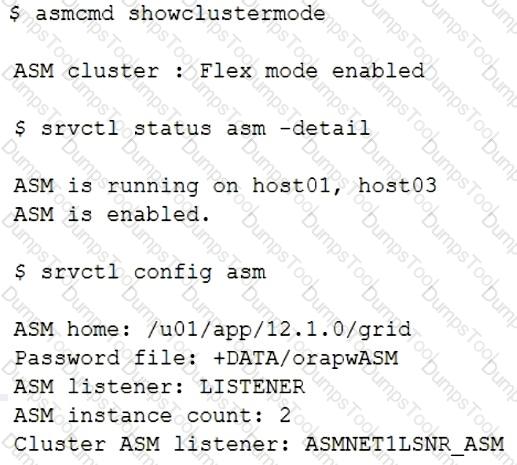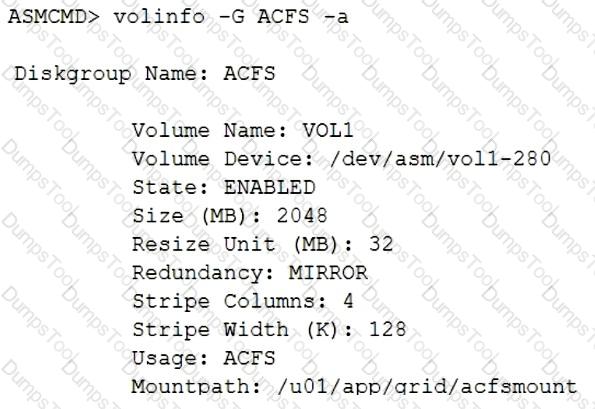Which four statements are true concerning the upgrading of Oracle Grid Infrastructure 19c? (Choose four.)
Examine this command and output:

Examine this command:

Which statement must be true for the successful execution of the second command?
Examine these descriptions of ASM instance shutdown behavior:
1) The ASM instance shuts down immediately without an orderly dismount of disk groups.
2) Active SQL statements are allowed to complete before an orderly dismount of all disk groups occurs and then the ASM instance shuts down without waiting for connected sessions to disconnect. If any ASM clients are connected to the instance, then the shutdown returns an error.
3) Active SQL statements are allowed to complete before an orderly dismount of all of disk groups occurs and then the ASM instance shuts down after waiting for connected sessions to disconnect. If any ASM clients are connected to the instance, then the shutdown returns an error.
Which two lists are correct matches for these descriptions? (Choose two.)
Zero Downtime Patching uses Fleet Patching and Provisioning to patch Oracle Grid Infrastructure without bringing down Oracle RAC database instances.
Which three statements are true about Zero-Downtime Oracle Grid Infrastructure Patching? (Choose three.)
Which three statements are true about accessing ASM files? (Choose three.)
Which two statements are true about Oracle Clustered ASM performance? (Choose two.)
Which three statements are true regarding ASM on a four-node cluster? (Choose three.)
Which two statements are true about the Global Enqueue Service, Instance Locks, and global enqueues in Oracle 19c RAC? (Choose two.)
Examine this command:

Which two statements are true about this disk group, created using Grid Infrastructure 19c? (Choose two.)
You administer a RAC database that currently runs on a four-node cluster but which has three instances.
Which two statements are always true about redo logs for this RAC database? (Choose two.)
Which two statements are true about load balancing using a database service in a RAC environment? (Choose two.)
Which two statements are true regarding ASM Dynamic Volume Manager (ADVM)? (Choose two.)
A Java application using thickJDBCconnections will soon be deployed, and you must configure a RAC database to support highly available connections.
Broken connections must be re-established as quickly as possible.
Which feature will support this requirement?
Which three statements are true about ASM Cloud File System (ACFS) encryption? (Choose three.)
Examine the output of theasmcmdandsrvctlcommands:

Then you execute this command:
$ srvctl relocate asm -currentnode host03 -targetnode host02
Which three statements are true regarding the execution of this command based on the output shown? (Choose three.)
Which three statements are true concerning Automatic Database Diagnostic Monitor (ADDM) for RAC? (Choose three.)
Which two actions guarantee that time is synchronized properly on all nodes in a cluster after installing Oracle Grid Infrastructure 19c? (Choose two.)
Examine the output of this command:

TheACFSdisk group is a normal redundancy disk group with 5 GB of free space.
To increase the size of theACFSfile system, you execute this command as therootuser:
$ /sbin/acfsutil size +200M /u01/app/grid/acfsmount
Which two statements are true regarding the outcome of this command? (Choose two.)